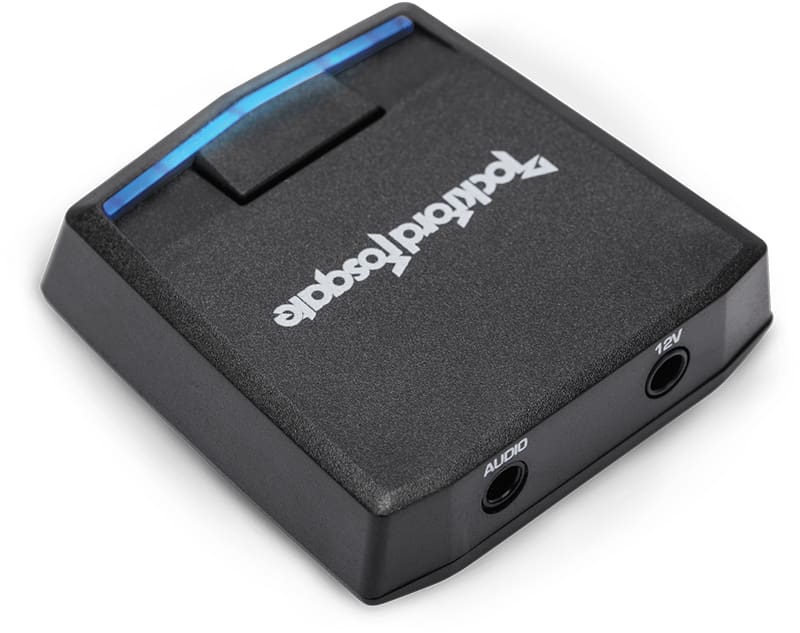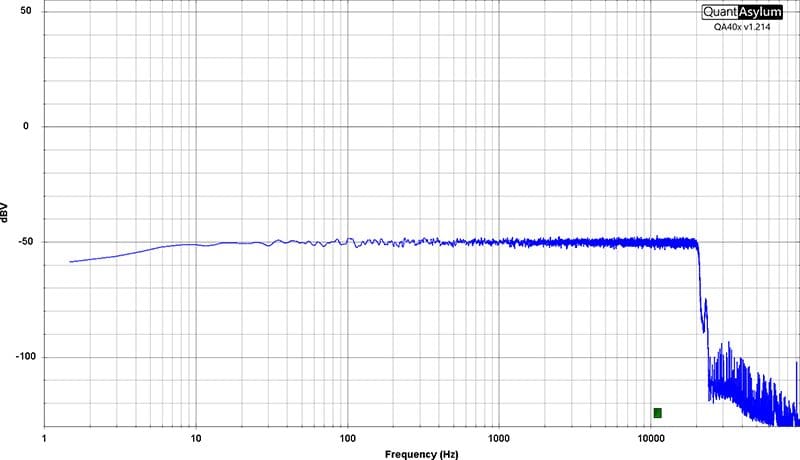When it comes to powersports, motorcycle, marine and hot rod audio systems, many of these solutions are designed with convenience and stealthiness in mind. As such, they will use a Bluetooth audio receiver in combination with a smartphone rather than a conventional source unit. The Rockford Fosgate RFBTRCA Bluetooth receiver is designed specifically for applications like these, so let’s check it out!
What Is Bluetooth?
Let’s start by explaining what Bluetooth is and what it can be used for. Bluetooth is a low-power digital communication protocol that was designed as a replacement for serial communication cables. It’s commonly used for connecting gaming controllers to consoles, keyboards and mice to computers, and remotes to iOS and Android media players.
Bluetooth operates using several different protocols to facilitate communication between two devices. For example, in the original Bluetooth implementation, we had the Headset Profile (HSP), which allowed a wireless earbud to replace a wired connection to a cell phone. The Headset Profile was replaced with the Hands-Free Profile (HFP), which added features like answer, call reject, end, redial, and more. HFP also added voice dialing. This connectivity evolved into car radios that could display contacts from a smartphone using the Phone Book Access Profile (PBAP).
Jumping ahead four years to 2003, Bluetooth added the Advanced Audio Distribution Profile (A2DP). This profile enabled stereo audio playback over a wireless connection and was part of Bluetooth 1.2. A2DP utilizes several different data compression algorithms for audio streaming, commonly called codecs. You can think of these as similar to ZIP and RAR compression for computer files. These codecs include SBC, AAC, aptX and LDAC. Newer versions of codecs make increasingly impressive claims about bandwidth and sound quality.
Another profile important for audio streams is the Audio/Video Remote Control Profile (AVRCP). This set of commands enables your radio to pause playback, skip songs, display album art, and show song metadata, including title, artist, album and composer information.
The key takeaway here is that Bluetooth is essentially a digital communication system. The functionality we’ve come to enjoy is all based on the different profiles included in the products we use. Importantly, not all devices support all profiles. Never assume they do unless it’s expressly noted.
What Is the Rockford Fosgate RFBTRCA Receiver?
The Rockford Fosgate RFBTRCA is a Bluetooth receiver designed to stream music from your smartphone (or a similar device) and provide a direct signal to a car radio with an auxiliary input or to an amplifier. The RFBTRCA is impressively compact, measuring 0.51 inches by 1.9 inches by 1.95 inches. The unit connects to a 9–16 VDC power source using accessory and ground wires. The output is a 3.5mm (1/8-inch) TRS jack, similar to the one found on a digital media player for headphones. Rockford Fosgate includes a 1-meter-long 3.5mm-to-RCA cable with the unit.
The RFBTRCA operates on Bluetooth Profile 3.0 + EDR. What does this mean? Earlier Bluetooth profiles were limited to 1 Mbps of data transfer. The Enhanced Data Rate (EDR) addition increased the bandwidth to 3.0 Mbps. The bottom line is improved audio quality over devices that use Bluetooth 2.0 or earlier versions.

Applications for the RFBTRCA Interface
Let’s discuss where and how the RFBTRCA interface can be beneficial in building an audio system. Suppose you have a classic car and don’t want to change the radio to something modern. Your installer could hide an amplifier, such as the Prime Series R2-750X5, in the trunk to run the front and rear speakers, along with a compact subwoofer enclosure. Connecting the output of the RFBTRCA to the amp will allow you to use your smartphone as the audio source. You can play music files stored directly on the phone or stream audio from online services like Pandora, iHeartRadio, Spotify, or Tidal. If you want to make the system cool, add the Rockford Fosgate PMX-BTUR remote to the steering wheel to control volume and track selection. The remote mounts with a Velcro strap, so you don’t alter the vehicle during installation.
Another similar application might be in a side-by-side or a personal watercraft like a Sea-Doo. An amp can be hidden to power the speakers, and you can stream your favorite music from your smartphone using the RFBTRCA interface.
If you have an older radio without Bluetooth audio streaming, you can use the RFBTRCA to play music through the auxiliary input. It’s worth noting that the RFBTRCA only supports the A2DP profile and not HFP or HSP. As such, it’s not designed to handle phone calls. The unit doesn’t include a microphone, so there’s no way to provide outgoing audio to the caller.
RFBTRCA Interfacing Simplicity
When the RFBTRCA is first powered, the center of the LED bar on the bottom edge will illuminate blue. When in pairing mode, the left and right sides of the bar will blink blue. Once your smartphone or media player is connected to the RFBTRCA, the entire bar will illuminate blue, and a pairing chime will play.
Speaking of connecting, when nothing is connected, the RFBTRCA automatically switches to pairing mode, making it visible to any Bluetooth audio streaming device, such as a smartphone, tablet or laptop. The unit broadcasts “RFBTRCA” as the name. You simply select it, and the pairing process finishes automatically. There are no codes to enter to complete the process.
Once the RFBTRCA is paired with a mobile device, it remembers it. This is handy when returning to the vehicle, as the RFBTRCA automatically reconnects to your mobile device. There’s no need to pair each time you re-enter the car, truck, boat, side-by-side, motorcycle, ATV, canoe or whatever you’ve got your tunes in.
To connect a different device, disconnect from the RFBTRCA. It will automatically revert to pairing mode. You can then select it from the new device and start playing music.

Testing the RFBTRCA Universal Bluetooth to RCA Adapter
There aren’t many functions on the RFBTRCA. It simply accepts a Bluetooth audio signal from a smartphone and provides a stereo audio output that can be fed to a radio or amplifier. There is a small button on the chassis, located just above the LED bar, that acts as a play/pause button when pressed.
We set the RFBTRCA up on our test bench. We fed the output into our QuantAsylum QA403 audio analyzer to measure the maximum output voltage, audio signal frequency response and 1 kHz distortion characteristics.
Let’s start with output voltage. For this test, we used a Dell XPS 13 laptop with its built-in Bluetooth transceiver. It quickly became apparent that it’s crucial to disable all audio enhancements in the device profile to provide accurate measurements. Before we did that, we saw more than 10 dB of variation in frequency response and only half the maximum output voltage.
Playing a 1 kHz test tone recorded at 0 dBFS, we measured 0.9421 volts on the output of the RFBTRCA interface. The specification rates the output at 0.8 volts, so it exceeded the rating by a significant margin.
Next, we used the same 1 kHz test track to analyze the distortion characteristics of the output. Keep in mind that even the best Bluetooth codecs can’t match what’s available from even the most modest aftermarket sources or files played from a USB memory stick.

The measurements show impressive performance, with THD+N at a very respectable 0.0657%. The THD measurement without noise was 0.0364%. That exceeds some entry-level B-brand source units and all Android-based units from Amazon we’ve tested. The signal-to-noise ratio measurement was 65.86 dB, which is solid.
Finally, we recorded a 600-second-long white noise track for a frequency response measurement. The track is in a 192 kHz, 24-bit format to provide as much bandwidth as possible. We played the track and used the averaging feature on the QA403 to smooth the waveform and generate a frequency response graph.

As you can see from the above measurement, the RFBTRCA was very smooth, with the -3 dB limits at approximately 4 Hz on the bottom end and just over 20 kHz on the top end. This is impressive!
Auditioning the RFBTRCA Bluetooth Receiver
Had we not done multiple sets of measurements and turned off the audio enhancement features in Windows, our listening session with the RFBTRCA would have gone very differently. We initially saw a 10 dB bump at 60 Hz and more than 10 dB of variation in frequencies above 10 kHz. With everything turned off, as we just demonstrated, the response was ruler-flat. We connected the RFBTRCA directly to our high-bias Class-AB amplifier, powering a set of 2.5-way bookshelf speakers. Once again, we used the Dell laptop as the audio source.
The first track we auditioned was “The Man Who Sold the World” by David Bowie. This track had a broad presentation with percussion panned to the sides of the soundstage. Bowie’s voice has some processing applied to it, but it remained very clear and well-defined in the mix.
The second track was “Saturate” by The Chemical Brothers. On this one, we turned the volume up. The upper bass and midrange beat was clean and articulate. The track contains subtle clicks and pops, mimicking the sound of vinyl. They seemed realistic. The bass line was well-defined with solid low-frequency extension, something we expected based on the lab measurements.
Auditing anything Bluetooth-related is challenging due to how the system works. The RFBTRCA, like all other Bluetooth streaming solutions we’ve tested, suffers from a lack of transparency and clarity compared to a high-end source unit. This isn’t a fault of the device—it’s simply the nature of Bluetooth. Despite all the high-resolution claims from aptX and LDAC, Bluetooth was never intended for critical listening. But if you want background music or a way to enjoy your tunes in a noisy environment, such as on a side-by-side or boat, then it’s perfect. If your goal is highly accurate playback through premium loudspeakers, you’ll want a high-end source unit and your music stored on a USB drive.
Overall, the RFBTRCA performed exceptionally well. It pairs quickly and surpasses its specifications for frequency response and output voltage. Signal clarity measurements were also impressive. It sounds about as good as Bluetooth can sound.
Conclusion on the Rockford Fosgate RFBTRCA
If you’re looking for a convenient and hassle-free way to transfer audio from your smartphone, tablet, or portable media player to your vehicle’s audio system, the Rockford Fosgate RFBTRCA is a perfect solution. You can find an authorized Rockford Fosgate retailer near you using the Dealer Locator on the Rockford Fosgate website. Be sure to follow the Rockford Fosgate team on Facebook, Instagram, and YouTube to learn more about their products and the incredible events they attend.

